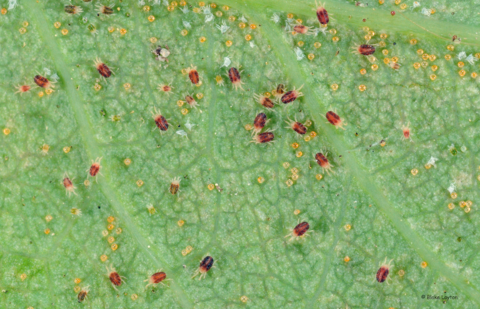Bug’s Eye View
Twospotted Spider Mites, Vol. 7, No. 12

Tetranychus urticae
Order: Acari
Family: Arachnida
Spider mites are important pests of many plants, including row crops, vegetable crops and ornamental plants growing in greenhouses, nurseries, and landscapes. Low populations of mites are not a threat and most plants in our gardens and landscapes probably harbor a few spider mites most of the time. But heavy spider mite infestations can cause serious injury or death to a wide variety of vegetable and ornamental plants.
Spider mites live on the undersides of leaves, where they find a suitable, protected environment and where they use their piercing, sucking mouthparts to feed on groups of cells. This feeding results in clusters of dead cells, and spider mite damage appears as a light stippling effect when viewed from the upper sides of leaves. Under high populations the damaged areas coalesce, causing damaged leaves to have a bronzed or brown appearance. When infestations are heavy, mites produce large amounts of webbing, and it is this webbing that gives spider mites their name.
Hot, dry conditions are especially suitable for spider mite outbreaks. Hot, because spider mites develop faster at warmer temperatures. In one study that reported average development time on green bean, cucumber and pepper, spider mites took an average of only 6.5 days to develop from egg to adult at 95oF, but it took 16.2 days at 59oF. Dry, because spider mites are susceptible to outbreaks of pathogenic fungi such as Neozygites floridana, but these fungi require high relative humidity to infect mites.
Insecticide sprays, applied to control other pests, can trigger or “flare” spider mite outbreaks—by killing predatory mites and insects that help keep spider mite populations suppressed. There are even some insecticides that cause spider mites to grow faster and to lay more eggs, a phenomenon known as hormolygosis. Sometimes the old joke, “I think that stuff I sprayed is actually making them grow!” is real. Imidacloprid is one example of an insecticide that can flare spider mite populations in this way. Pyrethroid insecticides such as permethrin and cyfluthrin can also flare spider mite populations. This is why avoiding unnecessary insecticide sprays helps avoid spider mite outbreaks.
Control: Dozens of effective miticides are available for use by commercial vegetable growers and nurserymen. The key to successful mite control in commercial settings is to obtain thorough spray coverage and avoid using products from the same class of chemistry in successive sprays. Spider mites quickly develop resistance if repeatedly exposed to the same miticide. In large commercial greenhouse production and some field settings there are even predatory mites that can be used to control spider mites. See Bugs Eye View No. 22 of 2018 for an article on aerial application of predatory mites to control spider mites in strawberries.
Spider mite control is much more challenging for home gardeners because none of the effective miticides mentioned above are sold to the home gardening market. Avoid flaring spider mites in home gardens by avoiding unnecessary insecticide sprays and keeping plants watered during dry periods. Contact insecticides such as insecticidal soap, neem oil or horticultural oil can be used to control spider mites in home gardens, but thorough spray coverage to undersides of leaves is needed to obtain control.
For more information see page 13 of Extension Publication 2369, Insect Pests of Ornamental Plants in the Home Landscape.
See Extension Publication 2472, Insect Pests of Roses , for information on spider mite control in roses.
Blake Layton, Extension Entomology Specialist, Mississippi State University Extension Service.
The information given here is for educational purposes only. Always read and follow current label directions. Specific commercial products are mentioned as examples only and reference to specific products or trade names is made with the understanding that no discrimination is intended to other products that may also be suitable and appropriately labeled.
Mississippi State University is an equal opportunity institution.
Bug’s Eye View is now on Facebook. Join the Bug's Eye View Facebook group here.